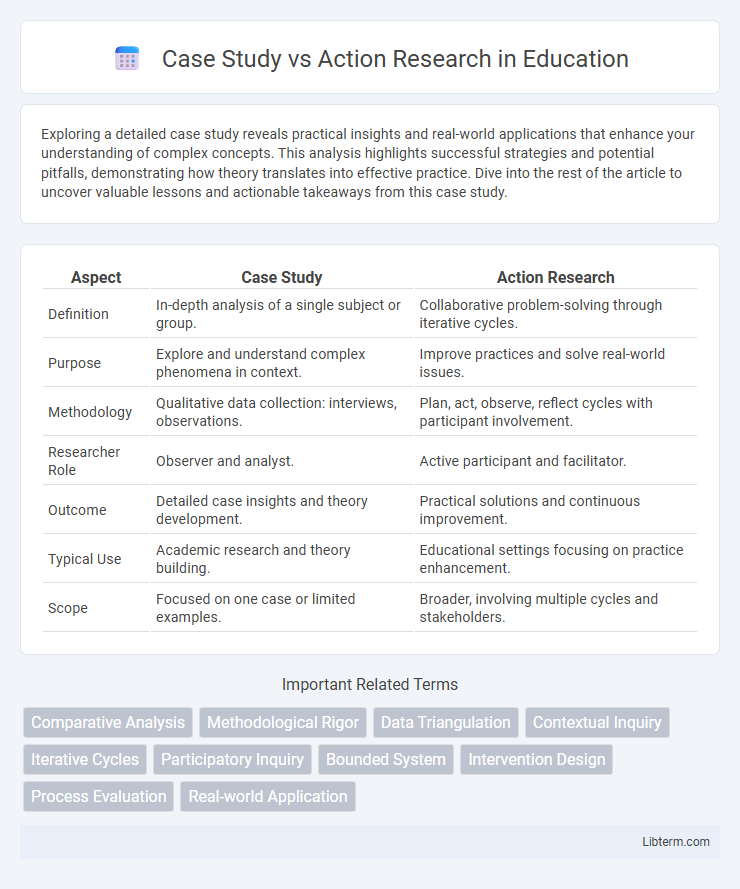Exploring a detailed case study reveals practical insights and real-world applications that enhance your understanding of complex concepts. This analysis highlights successful strategies and potential pitfalls, demonstrating how theory translates into effective practice. Dive into the rest of the article to uncover valuable lessons and actionable takeaways from this case study.
Table of Comparison
| Aspect | Case Study | Action Research |
|---|---|---|
| Definition | In-depth analysis of a single subject or group. | Collaborative problem-solving through iterative cycles. |
| Purpose | Explore and understand complex phenomena in context. | Improve practices and solve real-world issues. |
| Methodology | Qualitative data collection: interviews, observations. | Plan, act, observe, reflect cycles with participant involvement. |
| Researcher Role | Observer and analyst. | Active participant and facilitator. |
| Outcome | Detailed case insights and theory development. | Practical solutions and continuous improvement. |
| Typical Use | Academic research and theory building. | Educational settings focusing on practice enhancement. |
| Scope | Focused on one case or limited examples. | Broader, involving multiple cycles and stakeholders. |
Introduction to Case Study and Action Research
Case study research involves an in-depth, contextual analysis of a single case or multiple cases within real-life settings, aiming to explore complex phenomena through detailed examination. Action research emphasizes collaborative problem-solving by involving participants in the research process to implement and evaluate changes in practical settings. Both methodologies prioritize understanding specific contexts, but action research focuses on iterative cycles of planning, action, and reflection, while case study research focuses on comprehensive exploration and description.
Defining Case Study: Key Features
A case study is an in-depth investigation of a single entity, event, or phenomenon within its real-life context, emphasizing detailed contextual analysis and comprehensive data collection. It involves multiple sources of evidence such as interviews, documents, and observations to develop a nuanced understanding of the case's complexities. Key features include a focus on specific boundaries, a holistic approach, and the aim to provide empirical, real-world insights that contribute to theory development or practical application.
Understanding Action Research: Core Principles
Action research centers on collaborative problem-solving, emphasizing iterative cycles of planning, acting, observing, and reflecting to drive continuous improvement within organizations or communities. This methodology prioritizes active participation from stakeholders to generate practical knowledge directly applicable to real-world challenges. Core principles include reflexivity, democratic engagement, and a commitment to change, distinguishing action research from traditional case studies that primarily focus on in-depth analysis without necessarily driving immediate action.
Purpose and Objectives: Case Study vs. Action Research
Case study research aims to provide an in-depth understanding of a specific entity, event, or phenomenon within its real-life context, focusing on descriptive and exploratory objectives. Action research targets solving practical problems through iterative cycles of planning, acting, observing, and reflecting, with an emphasis on immediate application and change. The purpose of case studies is to generate detailed insights and theory development, while action research seeks actionable outcomes and continuous improvement within a community or organization.
Methodological Differences: Case Study vs. Action Research
Case study research involves an in-depth, contextual analysis of a specific case or cases, emphasizing detailed examination and exploration of complexities within real-life settings. Action research centers on iterative problem-solving through collaboration between researchers and participants, aiming for practical improvements and continuous feedback cycles. Methodologically, case studies prioritize descriptive and explanatory approaches, while action research employs cyclical processes of planning, acting, observing, and reflecting to address specific issues.
Data Collection and Analysis Methods
Case study data collection relies on multiple sources such as interviews, documents, observations, and archival records to provide a comprehensive understanding of a single or few cases. Action research employs iterative cycles of planning, acting, observing, and reflecting, emphasizing real-time data collection through participant feedback, surveys, and collaborative discussions. In analysis, case study methods often use thematic or pattern analysis to explore complex phenomena within a bounded context, while action research focuses on reflexive analysis aimed at improving practical outcomes and fostering organizational change.
Strengths and Limitations of Each Approach
Case study research excels in providing an in-depth, contextual analysis of complex phenomena within real-life settings, offering rich qualitative data and detailed insights but often faces criticism for limited generalizability and potential researcher bias. Action research emphasizes collaborative problem-solving and iterative cycles of planning, acting, observing, and reflecting, promoting practical improvements and stakeholder engagement while sometimes lacking rigorous control and producing findings that may be context-specific and difficult to replicate. Both methodologies contribute valuable qualitative understanding but require careful consideration of their respective strengths and limitations when applied to research objectives.
Practical Applications in Real-World Contexts
Case study methodology excels in providing in-depth analysis of specific real-world scenarios, enabling practitioners to explore complex phenomena within their contexts. Action research emphasizes iterative problem-solving through active collaboration with stakeholders, making it highly effective for implementing and evaluating practical interventions. Both methodologies support reflective learning and continuous improvement in organizational settings, with case studies offering detailed insights and action research driving tangible changes.
Choosing the Right Approach: Factors to Consider
Choosing the right approach between case study and action research depends on the research goals, context, and desired outcomes. Case studies excel in exploring complex phenomena within real-life contexts, emphasizing detailed analysis and theory development. Action research prioritizes iterative problem-solving and collaboration with participants, aiming to implement practical changes while generating knowledge.
Conclusion: Integrating Insights from Both Methods
Integrating insights from both case study and action research enhances the depth and applicability of findings by combining detailed contextual analysis with practical problem-solving strategies. Case studies offer comprehensive understanding of complex phenomena within real-life contexts, while action research facilitates iterative interventions and stakeholder collaboration for immediate improvements. Leveraging both methods supports evidence-based decision-making and continuous learning in organizational and educational settings.
Case Study Infographic

 libterm.com
libterm.com